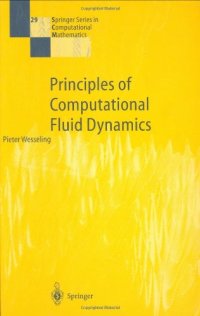
Ebook: Principles of Computational Fluid Dynamics
Author: Pieter Wesseling (auth.)
- Tags: Numerical Analysis, Mathematical Methods in Physics, Numerical and Computational Physics, Fluid- and Aerodynamics, Appl.Mathematics/Computational Methods of Engineering
- Series: Springer Series in Computational Mathematics 29
- Year: 2001
- Publisher: Springer-Verlag Berlin Heidelberg
- Edition: 1
- Language: English
- pdf
The book is aimed at graduate students, researchers, engineers and physicists involved in flow computations. An up-to-date account is given of the present state-of-the-art of numerical methods employed in computational fluid dynamics. The underlying numerical principles are treated with a fair amount of detail, using elementary mathematical analysis. Attention is given to difficulties arising from geometric complexity of the flow domain and of nonuniform structured boundary-fitted grids. Uniform accuracy and efficiency for singular perturbation problems is studied, pointing the way to accurate computation of flows at high Reynolds number. Much attention is given to stability analysis, and useful stability conditions are provided, some of them new, for many numerical schemes used in practice. Unified methods for compressible and incompressible flows are discussed. Numerical analysis of the shallow-water equations is included. The theory of hyperbolic conservation laws is treated. Godunov's order barrier and how to overcome it by means of slope-limited schemes is discussed. An introduction is given to efficient iterative solution methods, using Krylov subspace and multigrid acceleration. Many pointers are given to current literature, to help the reader to quickly reach the current research frontier.
This up-to-date book gives an account of the present state of the art of numerical methods employed in computational fluid dynamics. The underlying numerical principles are treated in some detail, using elementary methods. The author gives many pointers to the current literature, facilitating further study. This book will become the standard reference for CFD for the next 20 years.